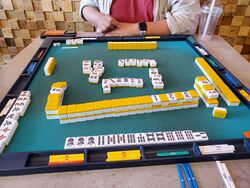Chiniisou: Difference between revisions
No edit summary |
|||
| (3 intermediate revisions by one other user not shown) | |||
| Line 21: | Line 21: | ||
* [http://tenhou.net/0/?log=2013080614gm-0089-0000-x339040987b74&tw=1&ts=7 With] [[junchan]]. | * [http://tenhou.net/0/?log=2013080614gm-0089-0000-x339040987b74&tw=1&ts=7 With] [[junchan]]. | ||
}} | }} | ||
'''Chiniisou''' {{kana|清一色}} is a | '''Chiniisou''' {{kana|清一色}}, often called '''chinitsu''' {{kana|清一}}, is a [[yaku]] scored when the hand only has tiles of a single numbered suit. It is worth 6 han, but reduced to 5 if opened. It is sometimes called '''chinichi'''. | ||
==Tile patterns== | ==Tile patterns== | ||
| Line 45: | Line 45: | ||
==Formation== | ==Formation== | ||
Since only one suit can be used for this yaku, tiles of the two other suits will be discarded. As a consequence, a player aiming for a honitsu/chinitsu will often discard tiles of two suits. This is especially true when middle tiles and/or [[dora]] are discarded early on. | |||
===Complex wait patterns=== | ===Complex wait patterns=== | ||
Chinitsu is notorious for developing complex [[Machi#Complex_patterns|wait patterns]]. Since all 13 tiles are of one suit, it is easy for groups to mix together, forming multi-sided waits | Chinitsu is notorious for developing complex [[Machi#Complex_patterns|wait patterns]]. Since all 13 tiles are of one suit, it is easy for groups to mix together, forming multi-sided waits. | ||
== Compatibility == | == Compatibility == | ||
| Line 58: | Line 58: | ||
== Value == | == Value == | ||
As a standalone yaku, chinitsu is at least a [[mangan]] | As a standalone yaku, chinitsu is at least a [[mangan]] open and a [[haneman]] closed. An open chinitsu can easily become a haneman with a [[dora]] or another yaku. | ||
===Yakuman=== | ===Yakuman=== | ||
Due to the relatively high value of this yaku, chinitsu may be involved in the formation of [[kazoe yakuman]], especially | Due to the relatively high value of this yaku, chinitsu may be involved in the formation of [[kazoe yakuman]], especially closed. A closed chinitsu, worth 6 han, is almost half the requirement of 13 han; other yaku and/or dora will need to provide the rest. A certain pattern of chinitsu hand can become a regular yakuman, [[chuuren poutou]]. | ||
==External links== | ==External links== | ||
Latest revision as of 13:42, 12 August 2024
| Type | Yaku |
|---|---|
| Kanji | 清一色 |
| English | Flush |
| Value |
6 han (closed) 5 han (open) |
| Speed | Slow |
| Difficulty | Medium |
Chiniisou 「清一色」, often called chinitsu 「清一」, is a yaku scored when the hand only has tiles of a single numbered suit. It is worth 6 han, but reduced to 5 if opened. It is sometimes called chinichi.
Tile patterns

Using pinzu:
Using manzu:
Using souzu:
Formation
Since only one suit can be used for this yaku, tiles of the two other suits will be discarded. As a consequence, a player aiming for a honitsu/chinitsu will often discard tiles of two suits. This is especially true when middle tiles and/or dora are discarded early on.
Complex wait patterns
Chinitsu is notorious for developing complex wait patterns. Since all 13 tiles are of one suit, it is easy for groups to mix together, forming multi-sided waits.
Compatibility
^ Ippatsu requires riichi to be of any use.
| RCH | DRI | IPP | SMO | TAN | PFU | IPK | ITT | YAK | SDJ | SDO | TOI | SNA | SNK | CHA | JUN | RPK | SSG | HRO | HON | CHN | CHI | RIN | HAI | HOU | CHK | |
| CHN |
Chinitsu requires a single suit with no honors. Yakuhai, shousangen, sanshoku, and sanshoku doukou all require honors or multiple suits, and are thus incompatible. Chinitsu implies honitsu, so they are not counted together. If combined with chanta, the hand is actually junchan, so that yaku is counted instead. Finally, chinitsu and honroutou would require a hand containing at most eight tiles (the 1s and 9s of one suit), which is impossible.
Value
As a standalone yaku, chinitsu is at least a mangan open and a haneman closed. An open chinitsu can easily become a haneman with a dora or another yaku.
Yakuman
Due to the relatively high value of this yaku, chinitsu may be involved in the formation of kazoe yakuman, especially closed. A closed chinitsu, worth 6 han, is almost half the requirement of 13 han; other yaku and/or dora will need to provide the rest. A certain pattern of chinitsu hand can become a regular yakuman, chuuren poutou.
External links
- Chiniisou in Japanese Wikipedia
- Game designed with sou tiles only to train reading chinitsu hands.
| |||||||||||||||||||||||||||||||
